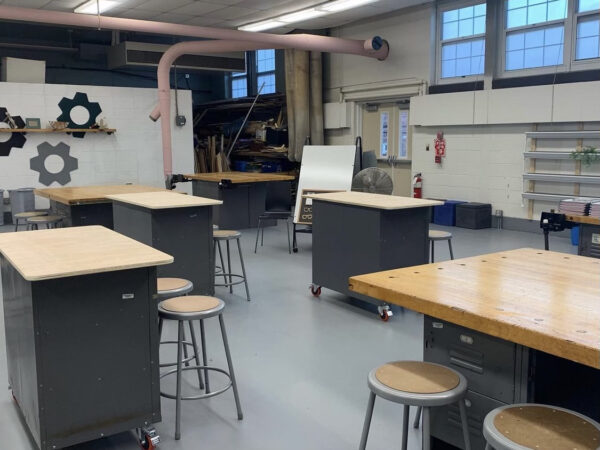While the Verona public schools may look the same on the outside this school year, there have been changes inside to present students with new ways of exploring technology. That will be most apparent at H.B. Whitehorne Middle School, which will be unveiling a remodeled lab for STEM and STEAM instruction, largely spearheaded by Technology, Engineering, & Design teacher Julia Zambrano. (She’s so committed to making the new lab a surprise for her students that she’s not letting MyVeronaNJ show a picture of it here; the photo above is the old class space.)
Verona schools have been adding more and more instruction STEM and STEAM. The acronyms refer to science, technology, engineering and math, and all that plus arts, and focus on using these disciplines to solve problems. Andor Kish used to teach just fifth and sixth grade computer cycles, which expanded into seventh and eighth grade by 2016. Rich Wertz, who wrote software for Wall Street before becoming a teacher, helped to introduce computer science courses at Verona High School. But while the curriculum evolved, the classrooms remained largely untouched, and space is a critical component in STEM courses. Zambrano came to HBW in 2015 and began to think about renovating the old woodshop into a more workable space for tech education.
“I mainly focused on rendering tables to make them more practical work spaces for students,” says Zambrano, who holds a bachelor’s in STEM from The College of New Jersey (TCNJ) as well as a master’s in special education. “I sanded old tables to make them easier to work on and put tables on wheels to make the room more flexible in terms of layout. I also added a pegboard to organize tools, and little renovations like that over time motivated me to plan for future developments, with the STEM lab being the goal.”
As STEM became more popular in Verona schools over the years, it was apparent that one thing was missing at HBW: a lab. Over the winter of 2021, Zambrano worked with colleagues and Supervisor of STEM Glen Stevenson to secure funding to remodel the woodshop.

“A renovation has always been a long term goal for the program,” Zambrano says. “I’m glad I was able to spend several years teaching in the space to develop a vision for an optimal layout. The challenges students tackle in the program are extremely diverse and require a flexible workspace. This renovation will more easily enable me to adjust the space to fit the needs of students at each stage of the process. The layout and furniture was chosen to facilitate students’ needs and better utilize the space.”
This summer, with only $40,000 in funding, the construction occurred, transforming the woodshop into a full-blown STEM lab. The new space features a testing “arena” for robotics courses, and whiteboards for students to brainstorm. More flexibility and physical space for the students to experiment and collaborate is essential in STEM and STEAM instruction.
As the space changes, so does the curriculum. Stevenson has been working on hiring faculty to offer more courses in these fields as enrollment increases, as well as refine course offerings. Next year, VHS will add robotics courses with the goal to engage more students in tech fields.
“The larger goal of these programs is to expose students to careers in STEM fields,” Zambrano says, “motivating them to become the next generation of scientists, developers, engineers, and mathematicians. Updating the programs and introducing the concepts at a younger age, to a larger portion of the student body, is just the start to help encourage and motivate more students to discover their passion for the subject.”

